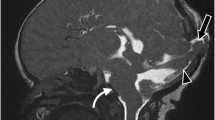Abstract
The clinical and MRI findings in two cases of rhombencephalosynapsis (RS) and two of tectocerebellar dysraphia (TCD) with an associated occipital encephalocele were studied to elucidate the clinical picture and embryogenesis of these rare anomalies. To our knowledge, only one case of TCD [1] and four of RS [2, 3] examined by MRI during life have been reported. The clinical picture in the cases of RS was rather constant and there were similarities with TCD. Consideration of the embryogenesis of the neural tube suggests a temporal proximity of the abnormalities, with TCD arising at a slightly earlier time.
Similar content being viewed by others
References
Truwit CL, Barkovich AJ, Shanahan R, Maroldo TV (1991) MR imaging of rbombencephalosynapsis: report of three cases and review of the literature. AJNR 12:957–965
Savolaine ER, Fadell RJ, Patel YP (1991) Isolated rhombencephalosynapsis diagnosed by magnetic resonance imaging. Clin Imag 15:125–129
Obersteiner H (1914) Ein Kleinhirn ohne Wurm. Arb Neurol Inst (Wien) 21:124–136
Gross H, Hoff H (1959) Sur les dysraphies craniocéphaliques. In: Heyer G, Feld M, Gruner J (eds) Malformations congénitales du cerveau. Masson, Paris, pp 287–296
Friede RL (1989) Developmental neuropathy, 2nd edn. Springer, Berlin Heidelberg New York, pp 347–371
Michaud J, Mizzahi EM, Urich H (1982) Agenesis of the vermis with fusion of the cerebellar hemispheres, septo-optic dysplasia and associated anomalies: report of a case. Acta Neuropahtol (Berl) 56:161–166
Padget DH, Lindenberg R (1972) Inverse cerebellum morphogenetically related to Dandy-Walker and Arnold-Chiari syndromes: bizarre malformed brain with occipital encephalocele. Johns Hopkins Med 131:228–246
Smith MT, Huntington HW (1977) Inverse cerebellum and occipital encephalocele: a dorsal fusion defect uniting the Arnold-Chiari and Dandy-Walker spectrum. Neurology 27:246–251
Inoue Y, Hakuba A, Fujitani K, Fukuda T, Nemoto Y, Umekawa T, Kobayashi Y, Kitano H, Ondyama Y (1983) Occult cranium bifidum. Neuroradiology 25: 217–233
Leong ASY, Shaw C (1979) The pathology of occipital encephalocele and a discussion of the pathogenesis. Pathology 11:223–234
Klein J, Palp KV, Bakr KA (1975) Rudimentary occipital meningoceles. A report of 5 cases. Acta Neurochir (Wien) 31:307–308
Altman NR, Naidich TP, Braffman BH (1992) Posterior fossa malformations. AJNR 13:691–724
Lemire RJ, Loeser JD, Lecch RW, Ellsworth CA (1975) Normal and abnormal development of the human nervous system. Harper & Row, Hagerstown, pp 144–163
Author information
Authors and Affiliations
Rights and permissions
About this article
Cite this article
Demaerel, P., Kendall, B.E., Wilms, G. et al. Uncommon posterior cranial fossa anomalies: MRI with clinical correlation. Neuroradiology 37, 72–76 (1995). https://doi.org/10.1007/BF00588525
Issue Date:
DOI: https://doi.org/10.1007/BF00588525




